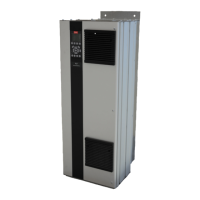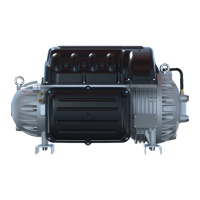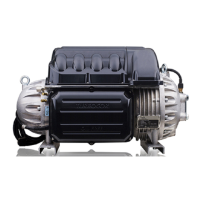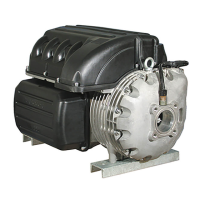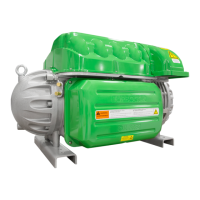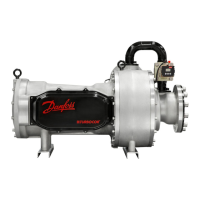246 of 282 M-SV-001-EN Rev. G
Motor Fault
Description
Trigger
Method
Troubleshooting
High Pressure Ratio
Fault
AFT • Suggests the condenser may be faulty, not enough load on the evaporator, or insufficient water flow in either
condenser or evaporator.
• Check the condenser, evaporator loads and water flow.
• Review the fault log for suction and discharge pressures and other conditions that are recorded at the time of fault.
Bearing/Motor
Fault
Active
INS • If a Motor Fault type or a Bearing Fault type is present, the Bearing/Motor Fault is triggered.
• This is not an actual fault, only an indication that a fault has occurred in the Motor or Bearing section. Refer to
"Table 5-8 Motor Status" on page 248 and "Table 5-5 Bearing Fault Types" on page 243.
Sensor Fault RFT • Review fault log for indication of values out of specified ranges recorded at time of fault. Verify the questionable
sensor and related connections for failure.
• Inverter temperature: The sensor embedded in the Inverter requires a replacement of the Inverter if determined
faulty.
• Cavity Temperature: Refer to "4.32.3 Cavity Temperature Sensor Verification" on page 232.
• Suction Temperature: Verify suction pressure/temperature sensor. Refer to "4.33.3 Pressure/Temperature Sensor
Verification" on page 234.
• Discharge Temperature: Verify discharge pressure/temperature sensor. Refer to "4.33.3 Pressure/Temperature
Sensor Verification" on page 234.
• Leaving Water Temperature: Verify LEAVE jumper is installed on I/O board.
• Suction Pressure: Review fault log for recorded value.
• Discharge Pressure: Review fault log for recorded value.
High SCR
Temperature
Fault
AFT • Indicates the SCR cooling is insufficient.
• If this fault occurs three times within a 30-minute period, a Lock-Out Fault will occur.
• Ensure the liquid motor-cooling line has sufficient liquid supply and is not blocked.
• Prevent prolonged operation at a pressure ratio less than 1.5.
• Verify the solenoids are operational and not blocked. Refer to "4.7.3 Solenoid Verification" on page 73.
• Verify the solenoid actuators. Refer to "4.7.3 Solenoid Verification" on page 73.
• Verify the Serial Driver. Refer to "4.27.3 Serial Driver Verification" on page 213.
• Verify SCR temperature sensor. Refer to "4.19.2.5 SCR Temperature Sensor Verification" on page 137.
• Verify SCRs. Refer to "4.19.2 SCR Verification" on page 135.
Lock Out Fault INS • If any (or a combination of ) the faults listed below occurs more than 3 times within 30 minutes, a Lock-Out fault
will occur:
– Inverter Temperature
– SCR Temperature
– Motor High Current
– Inverter Error
– Rotor may Be Locked
– Back EMF is low
• Review fault log for indication of faults recorded at time of lock out fault. Determine cause of the faults and repair
as necessary.
• Cycle power to clear Lock-Out Fault. Active alarm/Fault Viewer in SMT allows the Lock Out counter to be monitored
High Winding
Temperature Fault
AFT • Indicates the Raw Motor Thermal Readout in the Compressor Monitor Tool has exceeded the maximum limit.
• Ensure the liquid motor-cooling line has sufficient liquid supply and is not blocked.
• Prevent prolonged operation at a pressure ratio less than 1.5.
• Verify the solenoids are operational and not blocked. Refer to "4.7.3 Solenoid Verification" on page 73.
• Verify the solenoid actuators. Refer to "4.7.3 Solenoid Verification" on page 73.
• Verify the Serial Driver. Refer to "4.27.3 Serial Driver Verification" on page 213.
• Verify the motor thermistor. Refer to "4.24.4.3 Stator Thermistor Resistance Verification" on page 193.
High Suction
Superheat Fault
AFT • Based on the compressor suction pressure and temperature values.
• Suggests high evaporator temperature combined with low evaporator pressure, insufficient refrigerant charge,
check valve has failed to open or the compressor has been running in surge condition for an extended period of
time.
• Check the charge, system load and entering air/water conditions.
• Verify check valve opens during compressor operation.
• Review the fault log for actual suction pressure and temperature, entering air/water temperature (if available) and
other conditions that are recorded at the time of fault.
• Verify suction pressure/temperature sensor. Refer to "4.33.3 Pressure/Temperature Sensor Verification" on page
234.
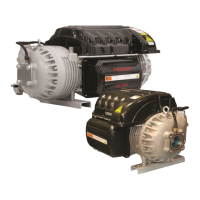
